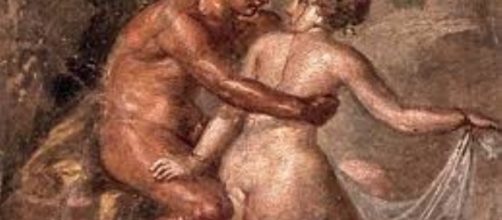Art Daily suggests that the House of the Chaste Lovers at Pompeii is the place to go on Valentine’s Day. It’s not. If the holiday still means a day of romance and enchantment, and if the word chaste still connotes innocence, the frescoes on the walls of this 1st century house are not choice. What you’d see are some pretty raw sex scenes. In fact, many are so explicit that rules of the road for Facebook and the news site that carries this column would likely disallow showing them. The image that accompanies today’s column is one of the benign examples.
Gluttony and goatishness in Old Rome
The ancient Romans were a crude lot. They ate and drank a lot and participated in sex orgies a lot. Historians have counted some three dozen brothels in the town of Pompeii with a population of about 11,000. By the look of their art, the old Romans had zero inhibitions. Mind you, there’s nothing on view in the House of the Chaste Lovers that we in the 21st century don’t do, except we don’t usually plaster pictures of what we do on our walls for anyone to see. Folks back then could see such imagery as well as carvings of phalluses all over their town, like “Pan Copulating with a Goat,” or Priapus, god of sex – a male figure in an aggressive stance with a penis the size of a large tree branch.
Both sculptures are now held at the Naples Museum. Scholars say that when King Francis I of Naples took his wife and daughter to see an exhibit of this stuff in 1819, unaware of the erotica on display, he immediately commended it all to be put out of sight. Only in 2000 was the collection made public again, although children are not allowed unless accompanied by an adult.
Maybe Mount Vesuvius was telling us something
Let’s face it, Pompeii society wasn’t the aristocratic Renaissance. They weren’t selective, which is why a homeowner would allow an image of a nude female bending over a male nude, apparently directing his sex organ into hers. But hey, when in Rome. Reportedly, Pompeii ranks number 2 on a list of tourist destinations in Italy (the Coliseum in Rome is first), which means that more than three million people have viewed this sort of art work every year.
But not for long. After Feb. 14, the House of the chaste lovers will be closed for four years for needed restoration. Michael Granatiero, head architect in charge of the project, told the press, he purposely kept the house open for Valentine's because he wanted the public to see it before closing. Apparently bad weather over the years has done damage. Odd, isn’t it? Pompeii was buried under mounds of stone and ash after Mount Vesuvius erupted in 79 AD intact, and the place needs refurbishing from some inclement weather.

